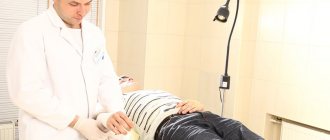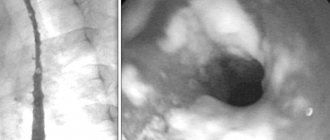Causes and symptoms
A chemical burn is associated with the effect of highly concentrated aggressive compounds on the skin and mucous membranes. The main cause of burn damage to the skin and eyes is accidental or intentional contact with chemicals, failure to comply with safety precautions at home and at work, errors in the choice of products, and the use of chlorine-containing detergents.
When toxicants come into contact with the skin or eyes, liquefaction necrosis develops - the tissue melts, becomes flabby, moist, and swelling, redness, and purulent infiltrate form around it. There is a risk of secondary infection.
At the burn site, an area of wet necrosis appears, covered with a white or black crust (eschar). After the scab is rejected, an ulcer forms, then a scar. How long a burn takes to heal depends on the chemical and the area and depth of the damage.
Chemical burns of the mucous membranes of the pharynx, larynx, esophagus and stomach occur after inhaling toxic fumes or ingesting chemicals. The main reason is the erroneous or deliberate ingestion of toxicants, unconventional treatment, and the use of alcohol substitutes.
Aggressive components enter the mucous membranes of the oral cavity, pharynx, esophagus, and damage the epithelium, causing necrobiosis - irreversible cell death.
When exposed to small doses of toxicants, only signs of chemical irritation and mild intoxication appear:
- pain in the abdominal area,
- burning and sore throat,
- feeling of suffocation
- nausea and vomiting,
- rapid breathing,
- swelling of the throat.
In severe burns of the pharynx and esophagus, the pathological process affects not only the mucous membranes, but also the submucosal and muscular layers. Chemicals penetrate into the deep layers, destroy red blood cells, and disseminated vascular coagulation (DIC syndrome) develops - massive internal bleeding.
Reference!
Alkalies cause a more pronounced burn of the stomach, acids - the esophagus.
At the stage of restoration and regeneration, necrotic tissue is rejected, a healthy mucous membrane is restored, and a scar is formed at the site of necrosis. With severe burns of internal organs, complete recovery does not occur - stenosis is formed, the patient suffers from chronic inflammatory diseases.
Substances that cause burns
Chemical burns are caused by various chemicals:
- alkalis: sodium hydroxide, sodium hydroxide, caustic soda;
- concentrated acids: acetic, hydrochloric, sulfuric;
- other substances: hydrogen peroxide, iodine, ammonia, acetone, silicate glue, potassium permanganate, phenol;
- household cleaning products;
- alcohol substitute.
More than 85% of chemical damage to the pharynx and esophagus in adults is caused by the intake of acetic acid, in children - potassium permanganate.
Reference! Most patients with esophageal burns are children under 10 years of age. The intake of toxicants occurs unintentionally, but due to the absent-mindedness of children, natural curiosity, and inattention of parents.
Experts' opinion
Clinical studies conducted with the participation of the Union of Pediatricians of Russia made it possible to establish that:
- When using the complex of products, the level of skin moisture decreased by 4% in comparison, and in the group that used Placebo, the level of moisture decreased by 9%.
- When using the complex of products, the level of skin acidity increased by 1% in comparison, and in the group using Placebo, the acidity level decreased by 1%, while in the second group of subjects the initial value of skin acidity was significantly higher.
- Skin moisture levels decreased slightly and remained in the dehydration zone, however, when used, the indicators remained significantly better than those of the group using Placebo. The level of sebum in general was initially low, and as a result, in the group that used alternative skin care products, it decreased by almost 2 times, and in the group that used it remained at the same level.
- When assessing the dynamics of the epidermal barrier indicators using the EASI diagnostic scale, in the group of patients who used the product, the average percentage of improvement when completing the full course was 28% and only 9% of patients remained unchanged, while in the group who used “Placebo”, 13% of patients showed improvement and 56% of patients without change.
Sources:
- Ratner Desiri, Avram M.R., Avram M.M., Procedures in Dermatology. Clinical cosmetology, Publishing house: GEOTAR-Media, 2019
- Sukolin Gennady Ivanovich, Clinical dermatology. A short guide to the diagnosis and treatment of dermatoses, publishing house: Notabene, 2017
- Schneiderman Paul, Grossman Mark, Differential diagnosis in dermatology. Atlas, Publishing house: Binom, 2017
Classification
Taking into account the depth of the chemical damage and the clinical picture, three degrees of skin burns are distinguished:
- I degree.
Incomplete damage to the skin or surface layer of the epithelium caused by a short-term or weakly intense substance. Local signs are limited swelling, redness of the skin, burning sensation and local pain. Healing occurs within 3–5 knocks on its own without scarring.
- II degree.
Accompanied by damage to the epidermis, with the formation of blisters filled with liquid transparent contents. After 2–3 days, the liquid becomes thick and jelly-like. Pain, swelling and redness at the site of injury are more pronounced. Tissue restoration continues for 12–15 days. The threat of infection increases.
- III degree.
Determined when the lower and superficial layers of the skin are damaged. There are two types: III degree A - the cells of the deepest basal layer are preserved, III degree B - necrosis of the entire thickness of the skin and the inner layer occurs. At the site of the burn, an area of moist necrosis, covered with a crust, forms. Rejection of the crusts occurs after 10–15 days, and complete healing of the burn injury takes 1–2 months. A rough scar forms at the site of skin damage.
In case of chemical damage to the mucous membranes of the respiratory and digestive systems, three degrees of severity are also distinguished:
- light
- damage to the surface layer of the epithelium;
- average
- damage to the level of the mucous layer;
- heavy
- injury to the mucous membrane and underlying tissues to varying depths.
Depending on the spread of the pathological process, burns can be isolated or combined.
First aid supplies
Before using any anti-burn therapy, you should consult your doctor . Be sure to read the drug instructions and contraindications.
Medical supplies:
- An ointment that has a bactericidal and bacteriostatic effect, as well as stimulating tissue regeneration in the affected area.
- Panthenol – healing and increasing tissue restoration.
Folk remedies for chemical burns are used mainly after medical care . They are necessary for the healing of affected areas of the skin or mucous membranes of the gastrointestinal tract.
Depending on the type of burn and the stage of healing, traditional methods of treatment include various medicinal and healing herbs, aloe and other compresses.
Complications of chemical burns
Extensive and deep local burn injuries lead to the development of burn disease, which is accompanied by a violation of the water-salt balance, circulatory disorders, depletion of the immune system, and intoxication.
With progressive burns, various complications arise:
- intestinal paresis - paralysis of the muscles of the intestinal wall;
- myocarditis - inflammation in the muscular lining of the heart;
- pericarditis - inflammation of the outer lining of the heart;
- pneumonia;
- bronchitis;
- pulmonary edema;
- pleurisy;
- glomerulonephritis is an immunoinflammatory kidney disease,
- pyelitis - inflammation in the renal pelvis.
Damage to deep tissues is aggravated by the formation of limited or diffuse purulent-inflammatory changes in the muscles, subcutaneous fat, the occurrence of sepsis, and arthritis. Undesirable consequences of burns include the formation of rough, inelastic scars.
Reference!
Exposure to any physical and chemical factor that causes incomplete damage to the surface layer of skin in an adult leads to deep trauma in children.
Burns to the eyes, esophagus, and respiratory tract are more severe and disrupt important vital functions.
Among the complications of chemical damage to the respiratory and digestive organs, the most common are:
- swelling of the larynx and pharynx,
- laryngeal stenosis - narrowing of the lumen,
- respiratory failure,
- phlegmon of the neck,
- chronic pharyngitis,
- perforation of the esophagus.
When chemical damage occurs to the deep layers of the mucous and submucosal membranes, toxic substances enter the systemic bloodstream and cause damage to the liver, kidneys, and brain.
The outcomes of severe eye burns include decreased visual function, atrophy of the eyeball, and formation of a cataract.
Treatment after burns
If you receive minor injuries, you can try to neutralize them on your own. If you have knowledge of how to treat superficial wounds, you can handle this yourself.
Ointment or gel for burns from boiling water helps well with kitchen problems. If second or third degree burns have been sustained, hospital treatment is required. It should be done in a clinic under the supervision of doctors. The therapist will recommend how to treat the burn or how to treat a burn with blisters.
First aid for a chemical burn
The further prognosis of a burn injury depends on how timely and competently emergency measures were provided to the victim.
How to provide emergency assistance:
- Limit human contact with the chemical.
- Rinse the burned area generously with water, a weakly concentrated solution of soda or citric acid.
- A fresh wound should not be treated with ointment, cream, spray, vegetable oil, or open the blisters yourself.
- For shallow burns limited to a small area, carefully remove clothing, apply a sterile bandage or bandage.
- For 3rd degree burns, wrap the victim in a clean sheet, give pain relief, call emergency help, or take him to a specialized medical facility yourself.
Before the ambulance arrives, it is important to drink warm water to prevent dehydration.
Eye burn
It is important to provide first aid for a chemical burn to the eyes on the spot.
Immediate measures:
- Rinse the conjunctival cavity with water or saline.
- Remove pus and mucus, chemical residues.
- Rinse the nasolacrimal canal with saline solution.
- Instill or apply an antiseptic drug into the conjunctival cavity.
It is strictly contraindicated to use neutralizing solutions on your own, since it is difficult to predict the reaction of substances to damaged tissue.
Burn of the esophagus and pharynx
First aid is provided at the prehospital stage or in the intensive care unit. To neutralize acids, use a soda solution, and alkalis - a weakly concentrated solution of acetic acid with oil. If the exact toxicant is not known, the oral cavity is washed with plenty of clean water at room temperature and given two glasses of milk to drink.
Important!
Washing is performed only in the first 5–6 hours after receiving a burn, after which the procedure is impractical.
What burns cannot be washed with water?
Remember that rinsing is contraindicated for burns caused by quicklime or organic aluminum compounds, which become much more active when in contact with water. The area affected by lime should be treated with vegetable oil, with which to remove the chemical compound from the surface of the skin, and then make a lotion from a 5% solution of citric or acetic acid. Aluminum compounds should be treated with kerosene or unleaded gasoline. If phenol gets on your skin, use a 40% solution of ethyl alcohol; if you get phosphoric acid, first remove particles of phosphorus from the skin, and then wash it with a 5% solution of copper sulfate or a solution of potassium permanganate.
Treatment of a chemical burn
How to treat a chemical burn depends on the depth and area of damage. 1st-2nd degree burns are superficial and can heal on their own. With progressive tissue damage, qualified medical care is required, removal of dead tissue with subsequent correction of scars. Treatment of burns is performed in special burn wards.
At the first stage, the burn surface is treated to prevent infection from entering the body:
- Treat the skin around the burn surface with an antiseptic.
- Contaminants and toxic residues are removed, large blisters are opened and emptied, the wound is filled with peroxide solution and dried.
- Apply ointment, cream or spray on top.
- For extensive and deep lesions, treatment of burn wounds is performed under anesthesia.
- The wound surface is protected with a bandage or left open.
In the first stages of tissue restoration, ointments, solutions and aerosols with analgesic, cooling and healing effects are used. If there is a scab, it is not removed, it is left until it is rejected on its own. Solutions with wax and paraffin are applied to the wound surface so as not to damage the growing epithelium during dressings. Salicylic ointment and proteases break down the dry crust formed during severe burns.
At the second and third stages, drugs are prescribed to activate metabolism, improve blood circulation, and protect against infections.
With deep burns and large areas of tissue damage, a person loses a lot of fluid and salts. To compensate for the loss of protein and water, prevent dehydration, and normalize the acid-base balance, nutrient solutions, glucose, and sodium chloride are administered through a dropper.
Treatment of esophageal burn
To remove the irritating substance, install a gastric tube treated with Vaseline, and wash the stomach with an antidote - water, soda solution, a non-concentrated solution of vinegar and oil. Anesthesia is performed first.
An antibiotic is administered to prevent infection. Next, taking into account the patient’s condition, analgesic, anti-shock, and detoxification therapy are prescribed.
In the subacute phase, after 7–10 days, bougienage of the esophagus is performed daily—expansion of the lumen using an endoscopic device. The procedure allows you to normalize the patency of the organ and reduce scarring. In case of stenosis and complete obstruction of the esophagus, the formation of coarse scars, surgical treatment is carried out as planned.
Treatment of eye burns
In the hospital, the patient is injected with anticholinergic drops into the conjunctival cavity. They relieve pain well and minimize the risk of adhesions. To prevent infection, use antibacterial ointments or drops. Antioxidants are administered intramuscularly. If intraocular pressure is elevated, antihypertensive drugs are prescribed.
For severe eye burns, hormonal therapy is used - subconjunctival injections (into the area of the transitional fold of the conjunctiva) and parabulbar (through the skin of the lower eyelid into the edge of the orbit).
In combination with pharmacotherapy, eyelid massage and physiotherapy have a good effect. If there is a threat of vision loss in the early period, surgical treatment is performed on the eyelids, eyeball, conjunctiva, and cornea.
What not to do?
1. Burned areas should not be lubricated with fats, ointments or sprinkled with starch.
2. Do not open blisters if they are formed from a burn on the surface of the skin.
3. Do not use tampons, towels or napkins to remove acid from the victim - this will only rub them into the skin.
4. If you are not sure what kind of acid you have suffered from, you should not try to neutralize it yourself! Simply wash the damaged area with water and a baking soda solution.
5. Under no circumstances leave the victim without professional medical assistance. The first aid you provide does not cancel calling an ambulance.
First aid
According to statistics, the degree and depth of damage to the cornea is influenced not by the type of traumatic impact, but by the duration of its contact with the surface of the eye. That is why everyone, without exception, needs to know basic first aid measures.
Important! A quick and correct reaction is especially important in cases where there is a thermal or chemical burn to the cornea of the eye.
What needs to be done to stop or reduce the influence of traumatic factors
:
- rinse the eye with a stream of cool, clean water, preferably saline, but regular tap water will do;
- remove foreign bodies from the surface of the eye, especially if they are hot metal particles (molten polymers should not be touched);
- Place a gel or ointment with an analgesic effect in the conjunctival sac to relieve pain and prevent the development of shock.
In the first hours after the patient’s admission to the hospital, doctors must rinse the lacrimal canals and remove foreign bodies embedded in the membrane of the eye. To prevent infection, chemically neutral antiseptic solutions are used to wash the eye.
Important! It is strictly forbidden to wash off chemical reagents from the surface of the eye with other chemicals, for example, acids and alkalis and vice versa, as this can lead to additional damage. Experts note that treating a combined corneal burn is many times more difficult than a specific type of burn.
Treatment
Intensive treatment of any type of burn of the cornea begins immediately after the patient enters a medical facility. To begin with, instillation of scopolamine and atropine directly into the eye is prescribed. These drugs relieve pain and reduce the formation of adhesions between the cornea and conjunctiva.
On the first day, the process of tissue change under the influence of traumatic factors continues. It is impossible to stop it completely, so doctors will have to wait until the necrotic processes stabilize. At this stage, it is important to prevent infection of the eyeball and reduce the intensity of symptoms. For this use:
- ointments and drops
with tetracycline, ciprofloxacin or chloramphenicol; - local non-steroidal anti-inflammatory drugs
- Diclofenac or Ibuprofen; - substitutes for tear fluid
to prevent drying of the cornea.
After stabilization of the condition, rehabilitation treatment begins. In the absence of perforations of the membranes of the eye, conservative methods are limited:
- injections of antioxidant drugs (methylethylpyridinol);
- placing gel-like regenerating preparations (Solcoseryl or Deskpanthenol) behind the eyelid;
- instillation of antihypertensive solutions (Betaxolol or Dorzolamide) into the eyes.
If the corneal burn is deep, hormonal agents are prescribed, most often glucocorticoids in the form of solutions for injection into the eyeball or conjunctiva.
Surgical intervention is used for deep and widespread damage to the membranes and internal structures of the eye.
If the anterior chamber of the eye is affected, corneal paracentesis is performed, followed by chamber sanitation. In case of deep damage to the eyeball, the dead areas of the conjunctiva, cornea, and vitreous body are removed, after which plastic restoration of the removed tissue is carried out.
In the long-term period, patients may require plastic restoration of the eyelids: elimination of eversion and entropion, ptosis, trichiasis, correction of post-burn cataracts, lamellar keratoplasty, etc.
Symptoms
Clinically, a corneal burn always manifests itself clearly and unambiguously: even without special knowledge, it is difficult to mistake it for another injury. The most striking symptoms of chemical and thermal burns are:
- acute, almost unbearable pain localized in the damaged eye and eyelid;
- reflex closure of the eyelids, photophobia;
- intense lacrimation (if the tear ducts are damaged, the sign may be absent);
- hyperemia of the skin, mucous membranes, conjunctiva;
- clouding of the cornea (noticeable with a severe burn).
Radiation damage may not be accompanied by unpleasant symptoms immediately after receiving it. Burning sensation, lacrimation, photophobia, hyperemia and photophobia appear after a few hours.








